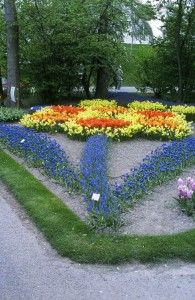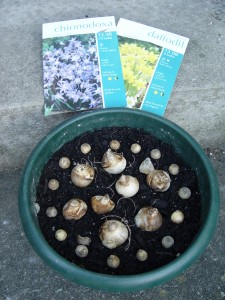10 Bulb Projects to Light Up Your Spring
October 23rd, 2008
Six tulips across the front of the house won’t give you much of a color splash in spring.
Now’s the time to plant something better. The next few weeks are still prime time for bulb-planting.
You might even run into clearance sales.
Try some of these 10 uncommon ways to light up next spring with bulbs of the non-electric kind:

Bulbs can spell out and draw all kinds of things.
1.) Message Me. Plant bulbs in a pattern that spells out a message or depicts an object.
One of my favorites is the “He Is Risen” message written in Easter-blooming daffodils along Bullfrog Valley Road near Derry Twp.’s Shank Park.
Hubbies: think of the points you could score by planting a heart-shaped bed of pink hyacinths with an arrow of dwarf daffodils through it.
2.) Make a “Bulbarynth.” A labyrinth is a meditative winding path typically built using stepping stones in a lawn. How about creating a labyrinth out of bulb-lined grass paths instead?
Dr. Bill Miller’s Cornell University horticulture class did just that, using a classic circular seven-circuit labyrinth pattern that you can copy at www.thebulbproject.org, a web site geared to educators and youth leaders.
This is different and impressive but surprisingly easy to do. Just line out the paths with string and flour, dig and plant bulbs along the lines.
3.) A Bulb Meadow. You don’t have to pick just one type of bulb and mass it out neatly as in a formal Colonial garden.
Especially if you like an action-packed loose look, buy a bunch of different bulbs and plant them randomly. In spring, you’ll get a riot of consecutive color that looks a lot like a wildflower meadow.
This is a great way to take advantage of year-end bargains of two packs of this, three packs of that, etc.

Bulbs placed in a pot, ready to be covered with more soil and then planted.
4.) Fool Mother Nature. Pot up a few plastic pots of bulbs and bury them in a leaf-lined trench.
In late January through early February, bring the pots inside, water and place near a sunny window. With any luck, you’ll have bulbs blooming inside weeks before they’d normally bloom in the ground.
This is called “forcing,” and it’s an excellent project to try with kids.
Even easier are paperwhites and pre-chilled hyacinths. These you just set in a water-filled pebble tray and watch them grow.
5.) No Dead Space Allowed. Get your yard off to an earlier start by planting clusters of bulbs between shrubs and perennials.
Most bulbs will poke up and flower by the time the shrubs and perennials are just starting to leaf out. Cut the bulb foliage when it yellows, and the shrubs and perennials will take over from there.
6.) Color for Key Spots. Add clusters of bulbs to prominent spaces that shouldn’t be bare until May flowers get going.
How about along the front walk? Around the mailbox or front light post? Maybe some fragrant hyacinths around the back patio? Or how about some golden daffodils at the base of an arbor or in front of a fence?
7.) A Colorful Groundcover. Ivy, vinca and pachysandra aren’t the only plants you’re allowed to use under trees.
Dwarf daffodils, Siberian squill and Spanish bluebells are three bulbs that do very well massed out under a tree or grove of trees. This splash of early-spring color can be replanted with summer impatiens in May.
I’ve got four trees tied together in a kidney-shaped bed of pachysandra with golden daffodils interplanted throughout. The daffs poke up above the pachysandra in April, then I cut the bulb foliage in May to leave a “regular” groundcover the rest of the season.
8.) Potted Bulbs. Foam, plastic and other winter-hardy pots can be planted with bulbs now. Let them sit out where snow and rain reaches them.
Come spring, the bulbs will emerge and flower in the pot. This is much cheaper than buying already-flowering bulb plants in spring.
Plant the potted bulbs in the ground after they’re done flowering.
9.) Coordinated Trios. Show off by planting circles or beds of three different bulbs coordinated by color and size.
You CAN do this by reading the bulb labels. Start by picking the same bloom time, then get a tall, medium and short variety, then pick specific ones that match colorwise.
In a circular or island bed, the tallest bulb goes in the middle, surrounded by the mid-sized ones with the shorties around the perimeter.
In a one-view bed, put the tall bulb in the back, the shortest one in the front and the mid-sized one in the middle.
Example of an April-blooming trio: tall white daffodils, mid-sized pink hyacinths, short blue-purple glory-of-the-snow.
Example of a May-blooming trio: tall yellow crown imperial, mid-sized red tulips, short purple grape hyacinths.
10.) Lawn Talk. Your neighbors will know you’ve gone off the deep end when you plant short early bulbs right in the lawn. Longwood Gardens suggests tommasinianus-type crocuses (“Tommies”) and snowdrops as two of the best choices.
Just toss the bulbs on the lawn and plant where they fall. It won’t hurt the lawn. Next March, the bulbs will poke up and flower as the grass is just thinking about greening up.
Hold off mowing as long as you can, and don’t use herbicides at least until the bulbs are completely dormant in late spring.
If you really want to get cute, combine this with Idea 1 and spell out a bulb message in the lawn.







